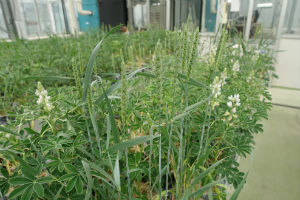 Changes in the rhizosphere interactions between wheat and white lupin along combined nitrogen and phosphorus gradients
Changes in the rhizosphere interactions between wheat and white lupin along combined nitrogen and phosphorus gradients
Given high population growth and the threat posed by imminent global climate change for maintaining ecosystem services, the outlines of tomorrow’s agriculture need to be redrawn. During the past 50 years, the use of nitrogen and phosphorus fertilisers has increased more rapidly than the production of food worldwide, which represents a major loss of efficiency in the use of N and P in agriculture.
Ecological intensification sets out to design and develop agroecosystems able to function with low inputs while maintaining high productivity. This approach uses concepts derived from ecology and is based on processes observed in natural communities. Of the methods used in ecological intensification, the association of crops uses plant diversity to improve the provision of various ecosystem services.
Aims
This project sets out to determine the direction and strength of belowground interactions between a cereal and a legume, depending on the availability of the nitrogen and phosphorus resources shared by the plants.
According to the ecological Stress-Gradient Hypothesis, along an abiotic stress gradient, interactions are dominantly competitive in plant communities with favourable abiotic conditions whereas interactions should tend towards facilitation as abiotic stress increases.
This project tests this theory using an approach combining modelling and experiments to answer the following questions :
- How does N and P availability affect the type and strength of the interactions between cereals and legumes ?
- What conditions can induce facilitation and when,
- What conditions may lead to transgressive overyielding in this type of association ?
Date
2015-2016
Funding
Pari Scientifique 2015 - INRA, Département EA
Contact
Simon Boudsocq, Eco&Sols, INRA Montpellier
e-mail :






